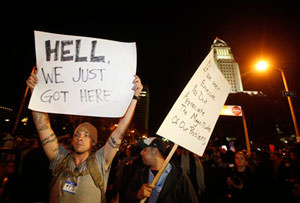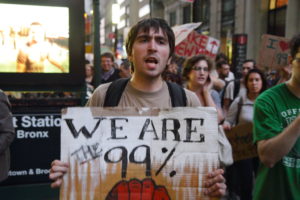Occupy 2012
In its two months of existence, Occupy L.A. showed a resiliency and purpose that could make some of its participants leaders in a great confrontation over economic injustice in the 2012 election. The election could be the next step for the Occupy movement.
The Occupy L.A. encampment didn’t look like an enterprise with a future. The skateboarders hurtling through the crowd, the soccer ball in the air, the treehouses, the young men and women sleeping in tents and in the open air made the place look more like a low-budget vacation at the beach than a protest movement.
Occupy L.A. was closed down early Wednesday morning by hundreds of Los Angeles police officers who arrested more than 200 in a comparatively peaceful operation that contrasted sharply with the conduct of cops in New York, UC Davis and other places. But its legacy is likely to be much more lasting than the abandoned tents and makeshift structures left behind at Los Angeles City Hall.
For in its two months of existence, Occupy L.A. showed a resiliency and purpose that could make some of its participants leaders in a great confrontation over economic injustice in the 2012 election. The same is true of the many Occupy movements, from Wall Street to Harvard Yard to Chicago, to Denver to Philadelphia, to Berkeley, Davis, UCLA and other places.
In other words, the election could be the next step for the Occupy movement.
The movement has taken the issue of economic injustice from think-tank reports, liberal columnists and Op-Ed writers to the streets. Many studies have shown, as Catherine Rampell noted in the New York Times Economix blog Oct. 10, that the top 1 percent of Americans hold about a third of the nation’s wealth, receive about 20 percent of the nation’s income and have a huge net worth. Now the Occupy movement has thrust this imbalance into the center of the national political debate. Ninety-nine percent to 1 percent says it all.
“I don’t think there will be a better economy next year,” Chapman University law professor Timothy A. Canova told me as we stood in the midst of the Occupy L.A. scene at City Hall on Monday, discussing what would become of the movement. Canova, a strong critic of the banking system who has been observing Occupy L.A., is on an advisory committee helping Vermont Sen. Bernie Sanders draft legislation to reform the Federal Reserve.
“Next year, there will be more unemployed people and next summer will be the hypocrisy of the presidential campaign,“ he said. “There could be a lot of leaders that come out of this movement. I think it will be back next summer.”
To understand how this could happen, recall the history of the protest movements against segregation and the Vietnam War.
Men and women, young and old, first organized against racial segregation. The students took the skills they had learned back to the campuses, with movements against college administrative evils and then the war. The older people met in front rooms, union halls, churches, synagogues and other places to fight against segregated schools and organize against the war.
At first, the mainstream media and politicians scornfully dismissed these movements, especially when it came to the Vietnam War. But the movement spread, fed by rising casualty figures, the draft and a realization that this war was a loser. I saw this in June 1967 when I covered a famous protest against the war at the Century Plaza Hotel in Los Angeles, where President Lyndon B. Johnson was speaking. More than 10,000 gathered in what was then a vacant field in front of the hotel. There were college students and the elderly as well as middle-aged men and women and young couples wheeling children in carriages and strollers. Opposition to the war had taken hold in the middle class.
The next year, the organizers and the organized became a powerful force in anti-war campaigns of Democratic presidential candidates Eugene McCarthy and Robert Kennedy, as well as other political efforts around the country.
Social protest has a long and unusual history in California. The state is noteworthy for long periods of surface calm, interrupted by explosions of its restless, diverse population, as happened in Watts in 1965, Hunters Point in San Francisco in 1966 and in Los Angeles again in 1992. Across the street from the Occupy L.A. site, union dynamiters blew up the old Los Angeles Times building in 1910 in a period of intense social discontent in which liberal grassroots organizations were suppressed by the police and business.
A California protest movement strikingly relevant to today began in 1933 when a physician, Dr. Francis E. Townsend, wrote a letter to his local Long Beach newspaper about the poverty among the elderly he had encountered in his Southern California community.
He proposed a $200 monthly pension for the elderly, an idea that resonated as much as 99 to 1 does today. He put his ideas into a pamphlet, which was distributed nationally. Mainstream politicians and media considered the doctor a crank, but Townsend Clubs were formed all around America. As the Social Security Administration points out on its website, “Townsend had tapped a major social problem in America (poverty among the elderly) and the nation was crying out for a solution.”
President Franklin D. Roosevelt disliked the Townsend movement, feeling the country couldn’t afford the $200-a-month pensions. But the SSA website notes, “There is some evidence that Roosevelt was prodded to introduce his Social Security proposal to counter the growing influence of the Townsend Plan.”
Francis Townsend is pretty much forgotten, except by the admirably thorough historians of the Social Security Administration. But he deserves remembering today when, as in 1933, the nation is gripped by economic troubles that are beyond the control of most people.
All through the country, angry and frightened Americans could be organized, just as Townsend Club members were during the Great Depression and just as Vietnam War skeptics were half a century ago.
Will their organizers come from this particular Occupy L.A. encampment? As I moved out of the way of a speeding skateboarder, I kind of doubted it.
But that was a momentary feeling. I had been visiting Occupy L.A. since October. I saw that what looked like a disorganized mess was, in many ways, a training ground for the election year ahead. Skateboards aside, young people were learning how to deal with others in organizing protests against what brought them together — income inequality and rapacious financial institutions. This is undoubtedly true of the Occupy movements throughout the country.
Like Dr. Townsend, they have tapped into a vast economic injustice. Their next chapter is yet to be written.
Your support matters…Independent journalism is under threat and overshadowed by heavily funded mainstream media.
You can help level the playing field. Become a member.
Your tax-deductible contribution keeps us digging beneath the headlines to give you thought-provoking, investigative reporting and analysis that unearths what's really happening- without compromise.
Give today to support our courageous, independent journalists.









You need to be a supporter to comment.
There are currently no responses to this article.
Be the first to respond.